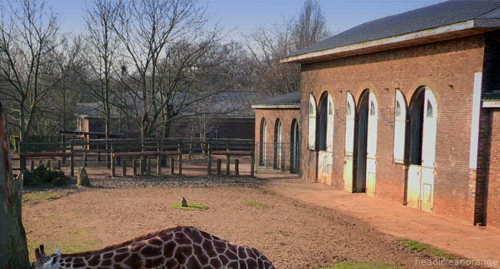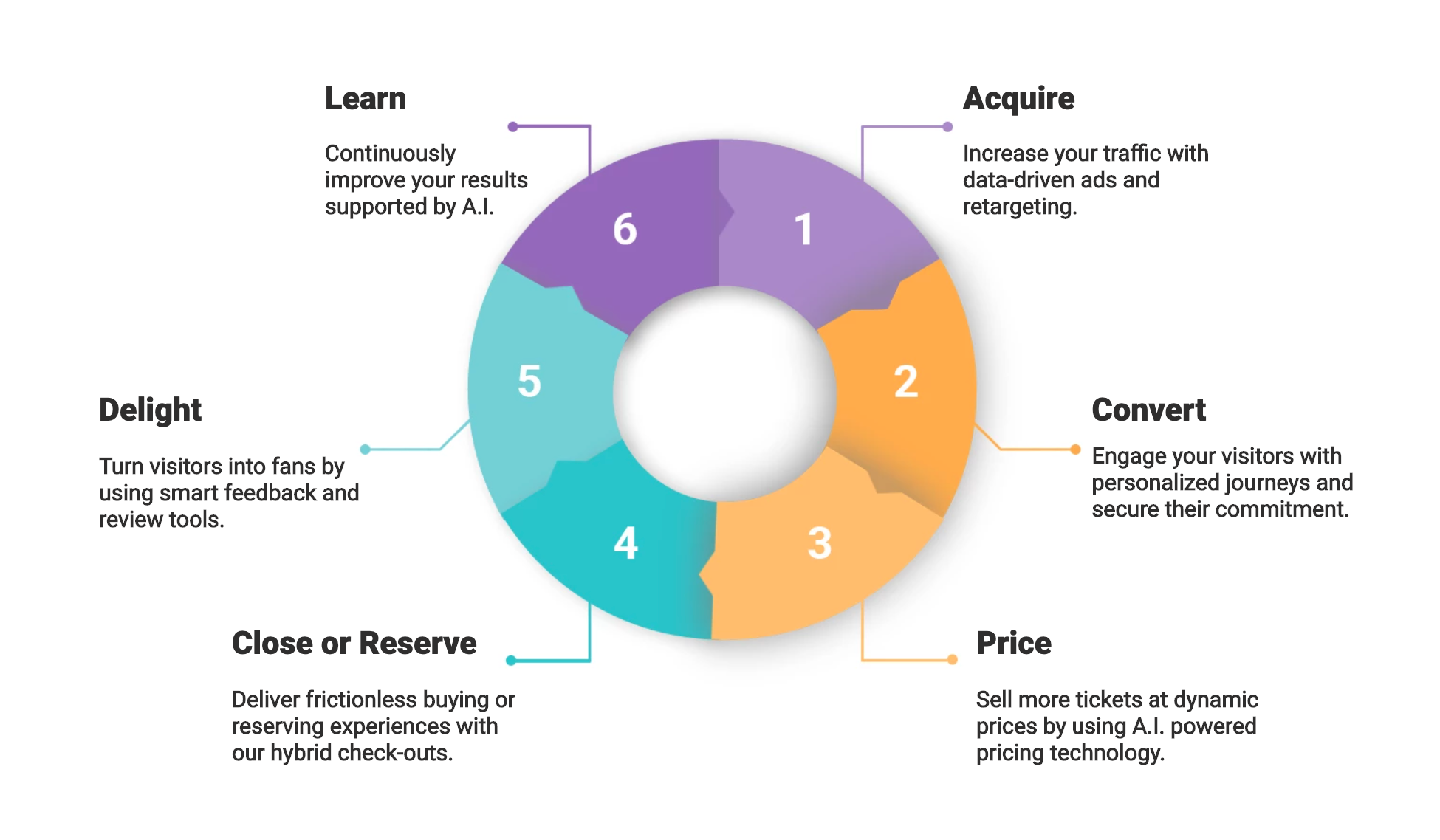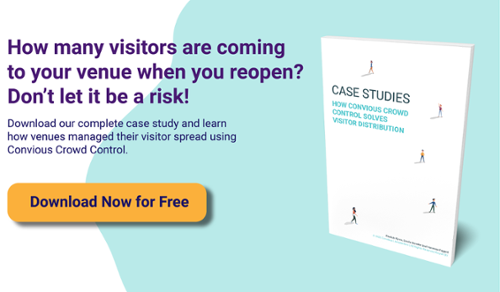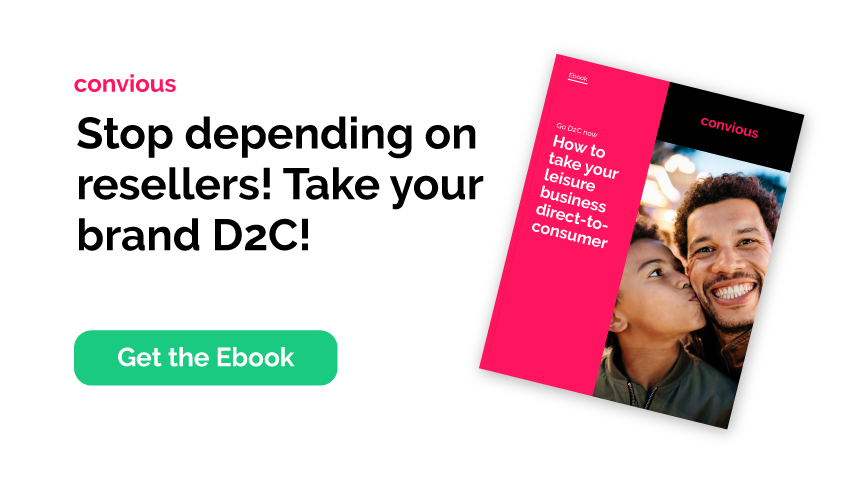The future of leisure's digital guest journey and how to get it right
Let’s admit it once and for all: digitalisation was long due in many areas within leisure. However today, we will focus on one of them particularly: Outdated and inefficient customer journeys. Ever wished things had been more smooth during your booking and visit experience to an attraction? You’re not the only one.
If you are a regular Convious Blog reader (if you aren’t yet, what are you waiting for? Subscribe right here - you won't regret it), you might have already read our latest blog post on why digitalising and modernizing your customer journey should be one of the urgent matters to tackle in your 2021 agenda.
Assuming that you are already well-aware of all the benefits involved, we are going to give you a clear example of a leisure customer journey, while providing you with actionable and specific tips on how to implement digitalisation and optimisation strategies in each of these touch points for you to be able to:
- Have a wider and more qualified reach of customers,
- ...influencing their purchase behaviour across multiple touch-points,
- ...and therefore, increasing conversions.
Sounds good? Then buckle up, because we are going to take you on a fun leisure day out with me and Mary through all of her customer journey.

Before you jump in on this ride with us, let me tell you: our destination is not just around the corner. It's a journey, and I am giving you a full guided tour, so it might take some time. However, if you don't want to stick around for long and just want to hop on and off between the different stages of the customer journey, here's a quick route plan that you can use to jump freely from one step to another:
Quick customer journey overview:
1. Awareness
2. Consideration
3. Booking/purchase
4. In-venue experience
5. Post-visit
1. Awareness

*when you realise you have a specific need, want, or wish - need recognition*
Mary is a single mother of two who works for a big Marketing Agency in the UK. As most of us, she has also been working from home lately, with the added responsibility of looking after her two children, Leo and Anna, while juggling all her tasks at home. Times have been busy and stressful during the past weeks, and the truth is that tension has been building up at home between her and the kids. Due to the piled-up stress, the atmosphere at home is starting to feel a little heavy.
Last night they were all having dinner when a Zoo advertisement appeared on TV, to which her kids reacted excitedly. She didn’t pay much attention at the time, but this morning she was hit with a couple other radio advertisements of nearby venues while driving to the supermarket, and now that she’s back home, scrolling down her instagram, the same Zoo ad has popped up in her feed.
Mary is no fool. She works in marketing and is well-aware of how smart advertisements work. Still, she clicks on the little airplane icon and sends the post to Martha, her sister. “Weekend getaway?” She adds.
So, as you can see, almost without even noticing, Mary has already entered the awareness stage of a customer journey and is already starting to consider going on a leisure weekend getaway of some sort.
This is the stage where the potential customer identifies a specific need or wish, which in Mary’s case is spending some leisure time to reconnect with her kids. At least the idea has popped up in her mind a couple times during the last few days. It’s in her radar.
During this phase, there’s multiple touch-points and channels that she has interacted with, consciously or not: radio, tv, social media, and online advertising for instance, which have ultimately influenced her customer sentiment making her think “It’s about time I do something a little bit different with the kids. This looks like fun!”
Therefore, when one of your target customers enters this phase, if you are not in their radar, and haven’t appeared in any of those touch-points, you will most likely not be considered for the following stage of their journey. And just like that, you’ve just lost a sale.
So this is why you should be putting in practice strategies that can ensure you will be present. In order to do that, at this stage of the customer journey, your marketing efforts and brand awareness will be key.
In this note, advanced advertising and smart retargeting techniques can be incredibly helpful, but they might not always be within your reach or expertise. However, you can still benefit from partnering up with world-class providers of digital marketing solutions such as Sojern, for example. They are specialised on the travel and leisure industry, and together with Convious’ all-inclusive data-driven eCommerce platform, they provide an excellent joint solution for attractions to effortlessly reach an audience who is already searching for experiences within their area, and influences them to book online seamlessly and directly through a high-conversion check-out, wherever they are. Such partnerships can help you make sure you are always in your target audience's radar.
But going back to Mary...
2. Consideration

*information search, evaluation of alternatives*
After getting her sister Martha involved in their weekend plans, now they are both exchanging back and forth different links and sites that they’ve found and are considering as options for their fun getaway with the kids.
Of course, the Zoo they saw advertised a few days back is still among the top options, but now, after going on a search their scope of venues they could visit has broadened. The climbing park or indoor playground in the region don’t look like a bad option either.
Comparisons are odious, right? But when it comes to the customer journey, there is no way to avoid them. Mary and Martha will start taking multiple factors into account in order to decide which of those weekend activities in the area is best suited for them.
They will visit different websites in order to check the weather, consider different routes to get there, compare different offers and prices, customer reviews, and so on.
Among some of the feelings that can arise along this phase of the customer journey (and over which you can influence) are thoughts like “there’s too many options, there’s not enough options, the prices are too high, the reviews are bad, the venue is too far, the weather forecast is good/bad…” and so on.
Basically, your mission at this point of the journey should be to differentiate yourself and highlight your added value. Why is your leisure venue a better option for Mary’s weekend getaway?
Within the leisure world, strategies such as:
- Next-level personalisation
- Dynamic pricing
- Engagement tools that help you drive conversions
...are not so common yet and can actually make a world difference in taking your potential customer to the next step of the journey.
Thanks to your great social media reach and smart advertising campaigns, Mary has made it into your venue’s website, just after visiting a couple others.
Most of the other sites didn’t have very clear messaging regarding their reopening status or policies, neither of their COVID19-proof measures, and the ones that did, actually required going down a rabbit-hole to be found.
However, when she enters your site she sees right away, thanks to a wonderbar at the top, that you are “OPEN AGAIN! Get your ticket and book a time-slot to feed our animals for FREE, away from the crowds!”. She knows that Leo would for sure enjoy feeding the elephants. Plus, your COVID19 messaging is very reassuring and seems like you’re offering a safe experience.
In addition, other venues seemed to have slightly overpriced tickets (especially considering that there’s a chance for rain). In contrast, your smart pricing algorithms have taken into account the weekend’s weather forecast and the drop in demand of course. Hence, adjusting the prices to fit better the market’s conditions and taking into account price sensitivities.
After her small online research and going on different venue comparisons, questions such as ‘Is this the best time to book?’ ‘Will it be too crowded?’ or ‘Is this the best price?’ have been successfully answered by your venue’s website, which helps Mary make her final decision of ordering for 4 tickets to your venue.
3. Booking/Purchase

*completes booking but might still be influenced by further offers/displays/deals*
If your customer has made it this far, and they have finally decided that you are ‘the chosen one’, you better have a frictionless and easy checkout flow that makes the process an absolute piece of cake!
Your aim here should be to close that booking and convert your visitors into paying customers. And how exactly can you do that? Well, here are some highly recommended practices to implement at this stage of the customer journey:
- A conversion-oriented frictionless check out. One that is friendly to all types of devices and that is clear, visually appealing, and fits your brand's look and feel seamlessly.
- A check-out that supports multiple languages.
- A check out that supports multiple product list flows and allows you to sell a great variety of products and ticket types in order to adjust to the many changes of the market. Don’t limit yourself to day tickets - sell Season Passes, flex and undated tickets, gift cards, bundles and more! Don’t you think Mary would be sold on a ‘family bundle’ deal?
- A check out that supports forms and collecting customer information (absolutely crucial at the moment for COVID19 tracking reasons and complying with government regulations, but also a great way to keep on nurturing your customers later on).
- Encourage an increase of the average cart value by offering smart upsells that complement your customer’s main experience (parking tickets, food menus, souvenirs, additional experiences etc.)
- Have Cart Abandonment emails connected! You wouldn’t want Mary to forget about the tickets she left in her cart, would you? If anything interrupts her purchase process (and with two kids running around chances are high), you want to be able to remind her and enable her to finish that order in just a few clicks.
- Allow multiple payment options and include payment trust logos so that your customers know that their payment is secure and payment doesn’t make them hesitate on whether to finalise that order or not.
- Omnichannel and in-app purchases. Today’s customers hop from one device to another. Make sure to allow them to book and purchase from you also through mobile, no matter where they initiated the booking process.
The Convious check out for instance allows customers to directly download their freshly purchased tickets on their phone just by scanning a QR code at the end of their process. And knowing how much Mary (and the rest of us mortals) hate eternally scrolling through the email inbox looking for tickets, you’ll surely delight them with this added perk for convenience.
4. In-venue experience

*when you get to enjoy the value of the money you paid for!*
A great leisure experience should begin even before the customer enters your venue’s doors. Before the in-venue experience there is a pre-visit phase, where you should build hype and excitement, as well as great communication to successfully manage your customer’s expectations.
Pre-event emails and push-notifications can be your best ally at the beginning of this stage.
Imagine if the night before visiting your venue for their weekend getaway, Mary would get a pre-event email that links to the tickets, reminds her of everything she needs to take with her, includes a weather forecast so she can choose her kids' clothes accordingly, indicates the route that she needs to take to get there, and even suggests a few complementary products she might want to buy to top up their experience!
That’s a great way to have her looking forward to her visit, and making sure things are smooth and easy, right from the start.
This could also be done directly through a mobile app, which gives her all of this information right at the tip of her fingers.
To know more about all the different ways you could amplify your in-venue experience through a mobile app, check out this related read with very specific examples: 3 mobile technologies to improve your zoo’s guest experience.
Mary, Martha, and the kids arrive at their selected time-slot to your venue and scan their tickets directly on their phones. Safe, and easy! And once inside, the true experience begins.
“Wow, that was quick, no long queues!” thinks Mary, who’s relieved not to find any big crowds at the venue.
That feeling of safety is something you could ensure for your venue by implementing Crowd Control technologies as well as a booking system that allows up-front reservations and time-slot bookings.
Recommended read: Why time-slots are here to stay for the leisure industry.
At this stage of the journey what your customers will really be looking for is for your venue to stimulate their senses and give them an immersive experience. Something that helps them get out of their routines and disconnect, while bringing them a unique value, whether that’s excitement, adrenaline, education, or a sense of discovery.
And I am sure you have already been doing just that - bringing memorable experiences to your guests - quite successfully for many years now.
However, times are changing and with new technology developments also come new opportunities to take your experiences above and beyond. Augmented reality and mobile technologies for instance will be of common use within the leisure world in the next couple years.
Related read: Guest-facing mobile apps: Leisure’s latest game changer.
So at this point of your customer journey, I invite you to really dive into the new possibilities available out there, and consider implementing a mobile app for your leisure venue. It’s true that developing your own app completely from scratch can be costly, and therefore is mostly only at the reach of the big players. But luckily, nowadays you don’t have to develop it yourself anymore. Instead of starting from scratch, you can just hop into the Tapp app.
If you desire to turn your customers into true fans, the gamification and personalisation opportunities with a mobile app, as well as the improvement of customer relationships, are endless.
5. Post-visit

*this is when your customer leaves your venue doors - it's your chance to turn a one-off purchase to a recurrent loyalty cycle*
Mary and the squad had a fantastic time at your venue. The kids had a blast feeding the animals, and learning new things about all the different species through games in your venue’s app, while Martha and Mary were delighted to avoid crowds at all times thanks to the heat-mapping function they could cheek on their phones on the go, and the smart alerts they were getting through push-notifications informing them of which areas were least crowded.
But now that they have finally left your venue’s doors… what’s next?
- There’s only two options: This could have been
...a linear customer journey. - ...a circular customer journey.
In a linear customer journey, there’s no repeat. The customer consumes your service and experience and once they leave your venue’s doors it’s over.
But that is not a smart approach, and definitely not one that you want to take as the customer-centric leisure venue you surely are.
If you truly want your customers to turn into recurrent die-hard fans, you can’t forget about them the moment they’ve walked out the gate. You need to nurture them, in order to turn their customer journey into a (hopefully) forever spinning circular wheel.

Within this stage of the customer journey, the key elements that will help you do that are smart feedback and review tools (by which your customers can let you know how they liked your offered experience), and post-event emails, through which you can re-engage your audiences, for example by including a discount promo code for their next visit or asking them to share a post or review about their visit.
There are many ways in which you can gather feedback, but if you don’t do anything with it afterwards...well, it’s kind of useless, isn’t it? Which is why it’s really important that you have a process in place that enables you to learn from every interaction in order to continuously improve your customer journey.
At Convious we provide our partners with an easy-to-use, A.I.-powered eCommerce solution that automatically adjusts and learns from the data. Because in the end, having data is the true key to understanding your audience better, and hence, being able to create (and improve) experiences that will ultimately delight your customers.
But, you cannot do that through third party resellers, because you lose control of your data and customer relationships. You can only have full control over that valuable information when the customers purchase and book directly through you and your owned channels.
This is also known as selling direct-to-consumer, and if you want to learn more about this revolutionary eCommerce strategy within the leisure world, don’t miss the chance to read up on the topic in our latest eBook.
You can get yourself a free copy just by clicking on the image below.
We hope that these insights and suggestions on the implementation of different technologies and best practices will help you drive more conversions and influence action in each stage of your customer journey.
If you have any questions or need guidance in putting them into practice, our team of experts is always willing to discuss your specific goals and help you out, so feel free to contact us.

